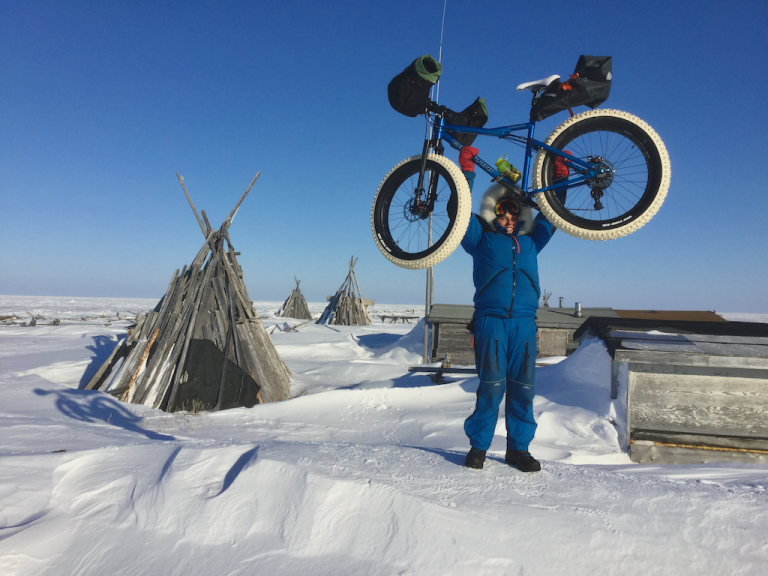This article was originally published in Wired For Adventure Volume 20. Expedition cyclist Kate Leeming divulges how she is training for the world’s first cycle across the Antarctic continent, all in aid of her education charity; Breaking the Cycle.
Antarctica has always fascinated me and the heroic explorers of the Antarctic and Australian continents continue to inspire. However, growing up on a wheat and sheep farm in Western Australia, the quest of cycling across the great white desert seemed an impossible dream.
The germ of the idea came at an unlikely moment. It was 45 ̊C as I sought the shade of a lone desert oak and gazed out across salt-encrusted Lake Disappointment. Found in Western Australia’s Little Sandy Desert, the lake shimmered in the midday sun. The mirage that hovered over the vast expanse gave distant islands the appearance of floating in the sky. Nine days into my ride up the Canning Stock Route and over its one thousand sand dunes, I was feeling worse for wear. Every day was over 40̊C and I was suffering the physical and mental effects of a dehydration incident from the previous day. Generating positive thoughts and imagery in challenging situations is an essential part of my mental toolkit and it was here, in the extreme heat, that imagining what it would be like to cycle across the frozen Antarctic plateau soothed my mind.
This 2004 Canning Stock journey (part of my 25000km Great Australian Cycle Expedition) was the last of mine to be completed on a regular mountain bike. Since then, fatbikes have changed the game on soft surfaces; sand and snow. The idea of cycling across the Antarctic and to the South Pole, which at that point no one had done (though some had spectacularly failed), incubated in the back of my mind during my 22000km Breaking the Cycle in Africa expedition (2010) and by 2012 I decided I had to do something about it.
Was cycling across Antarctica even possible? I thought that with the advent of fatbikes and my extensive experience of bike expeditions, particularly cycling in sand, it just might be. I may have been good at handling extreme heat, but cycling on snow and ice in the extreme cold was totally alien. I started by consulting Eric Philips, Australia’s most experienced polar explorer and guide. At the same time, I was searching for the ultimate polar bicycle and came across a design for an all-wheel drive (AWD) MTB that, compared to all the other innovations I’d seen, was the only system that appeared robust enough to cope with the extreme conditions. I tracked down its creator, Steve Christini, in Philadelphia and he loved the challenge of designing the first AWD fatbike for my polar quest. This meant designing it from scratch.
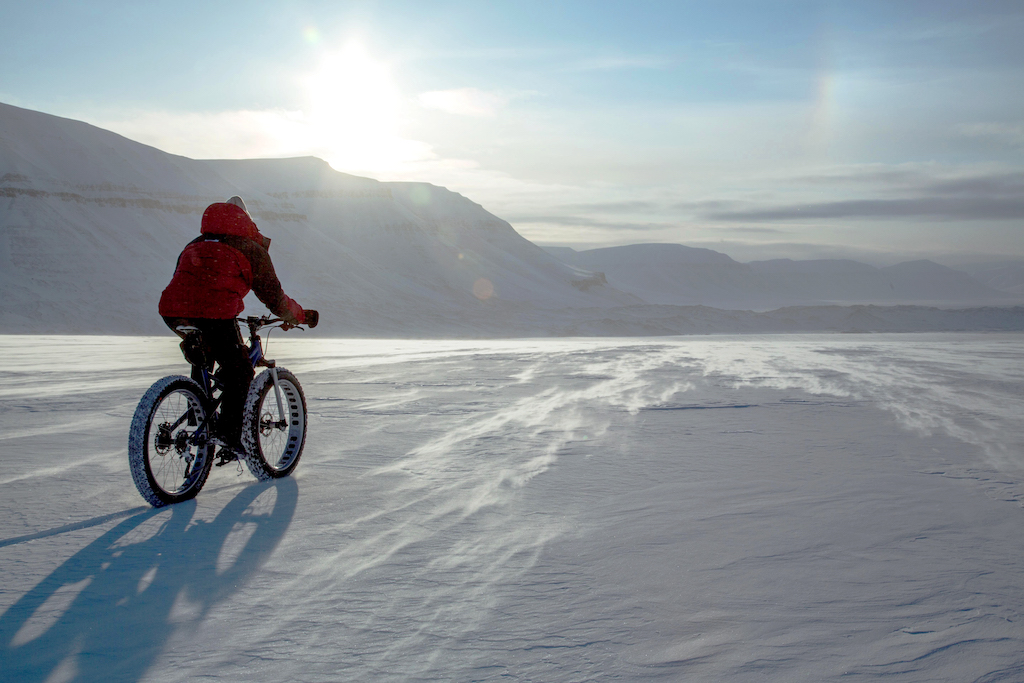
Svalbard
In 2013, I collected the first prototype in the USA en route to Svalbard, a Norwegian archipelago located at a latitude of around 80 degrees North, to determine whether my dream was doable. My team included Eric Philips, renowned Swiss documentary filmmaker, Claudio von Planta, and remote locations photographer and filmmaker, Phil Coates, who travelled from the UK. I not only needed to test my bike and hone my polar cycling and expedition skills, I felt it important to create some high quality content. To mount an Antarctic expedition is incredibly expensive and professional content was needed to attract the right sponsors.
Our week-long journey through Spitsbergen’s majestic mountains and fjords turned out to be a perfect training ground; from ice to deep snow, in temperatures down to about -30̊C and blizzards. I cycled a loop from Longyearbyen along Adventdalen and Sassendalen, up Rabot Glacier, then down Von Postbreen to Templefjorden and back to Longyearbyen.
On the whole, I found biking in the snow and sand to be similar in that it requires a huge amount of strength to stay upright and energy to deal with the constant resistance, without respite. However, the snow and calorie-burning cold was another level. It was a constant battle to regulate my body temperature. I generated so much heat with the effort that even in the extreme cold it didn’t take long to perspire. I was always zipping and unzipping vents on my clothing to try to control moisture loss without becoming too cold. Of course, the moment I stopped any sweat would freeze. I tried various combinations of clothing but in the end I was best in a single layer of thermals, a fleece mid-layer and a Mont shell suit made of Hydronaute fabric when I was cycling. The moment I stopped and blood drained from my extremities I dived for the down jacket.
The verdict on the performance of the world’s first all-wheel drive fatbike was that, while it needed some improvements in mechanical efficiency and tyre flotation, (it could only house a 4” wide tyre), it was an innovation worth developing. I needed a design that could house the maximal 5” wide tyres. Flotation over the soft surfaces is most important. The AWD system, which enables better grip, is the icing on the cake. The longer I can keep pedalling and the less time spent pushing, the more chance I have of success. There seems little risk with the AWD system because it can be switched off when it is not needed and it only adds just over a kilogram to the weight of the bike – which is negligible for my quest.
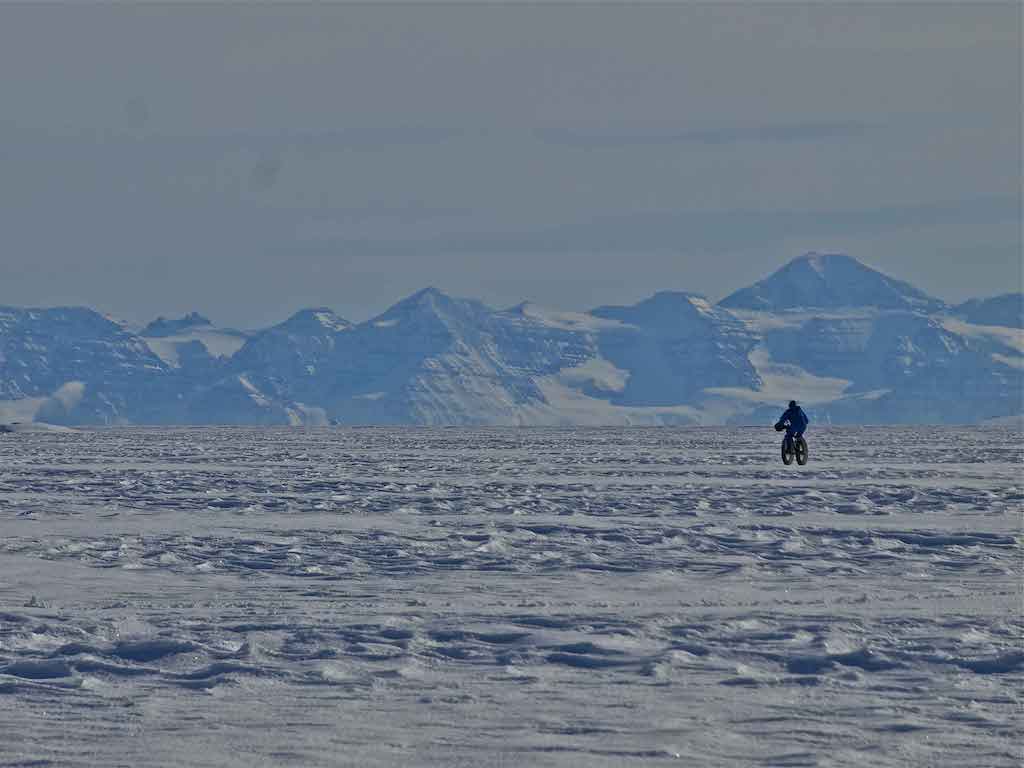
Northeast Greenland
It took three years to create another opportunity to hone my polar cycling skills on a new, improved Christini AWD bike. Claudio and I flew to Constable Point in Northeast Greenland where I made (what we think is) the first bicycle expedition through this region.
I was expecting to face temperatures of between –5̊C and -20̊C, however Spring arrived early and conditions were unseasonably warm. I had to wait for eight days before I could start the expedition because of a blizzard – typical of warmer temperatures. I couldn’t make the extended physical test I had hoped for and things were generally softer and wetter than I will expect to find in Antarctica.
Though, the seven days I spent out on the modified route were very testing and still provided valuable experience. I set off into the teeth of a howling arctic gale and then had to deal with a dump of soft fresh snow. Into the fourth day and conditions improved dramatically – the sun shone, the wind died down and I was treated to sweeping vistas as I pedaled for 50km, the length of spectacular Hurry Fjord, which separates the volcanic peaks of Liverpool Land from the sedimentary geology of Jameson Land. In the distance, the high mountains on the south side of Scoresby Sund, the world’s largest fjord, formed a stunning backdrop. I really found my rhythm heading down Hurry Fjord and after the trials of the first three days, I started to feel fitter and stronger.
From Hurry Fjord I turned off the sea ice and over some hilly terrain towards Ittoqqortoormitt, Greenland’s most northerly habitable town. My teammates (riding snow mobiles) thought that I would not be able to cycle most of this because of the steep climbs and soft, slushy snow, but the AWD function came into its own and, although heavy going, I climbed like a mountain goat and pedaled the whole way. The AWD system made it possible to ride on more difficult surfaces than a regular fatbike. Christini Mark II was a beautiful bike.
Kap Tobin was one of the most spectacular places I have experienced. Around the cape, the turbulent ocean currents were constantly shifting the icebergs and ice debris; swirling eddies caused ice blocks to collide or scrape past one another. Occasionally a chunk would sheer off and flip over to reveal its aquamarine underbelly. Although the seascape was constantly in motion, the atmosphere was tranquil and the icy waters perfectly clear.
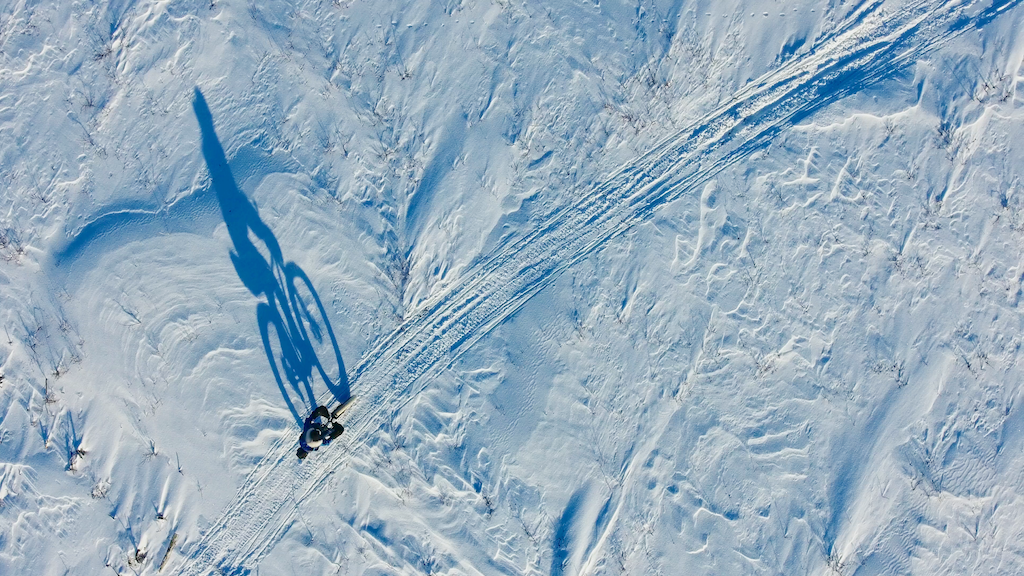
Arctic Canada
While the Greenland expedition was a great experience, I still needed a more extended physical challenge and to further refine my equipment and systems. In 2017 Claudio joined me for a third expedition, this time to the Yukon and Northwest Territories in Canada on the new Mark III which could fit VEE Tire Co’s 5.05″ (13cm) wide Snowshoe 2XL tyre on the rear for maximum flotation.
I cycled around 900km in total, along part of the Dempster Highway to Fort McPherson and ending at Tuktoyatuk. The route from Aklavik, along the Peel and Moose channels and across the Beaufort Sea to Shingle Point, had never been cycled before. In summer, the rich fishing waters around Shingle Point are a four- or five-hour boat trip from Aklavik. In winter, snowmobile is normally the only way to access the region. Locals tend to use the route for hunting. We met with indigenous peoples of the region, witnessed displays of the Northern Lights, and gained an appreciation for the harsh beauty of an Arctic winter environment.
For me, this was the most special part of the expedition, where I was confronted with properly cold conditions, more similar to what I am likely to face in Antarctica. Up until this point, my body had been suffering from the cold; my legs were swollen and my face was puffed up for much of the time. Somehow, on the most physically demanding part of the journey, where the energy requirements are probably three or four times higher than for normal cycling, my body seemed to respond positively. The swelling vanished. This was a great result and despite many bruises and a strained ankle from a series of heavy falls on the glare ice on the Beaufort Sea, I came through fitter, stronger and unscathed.
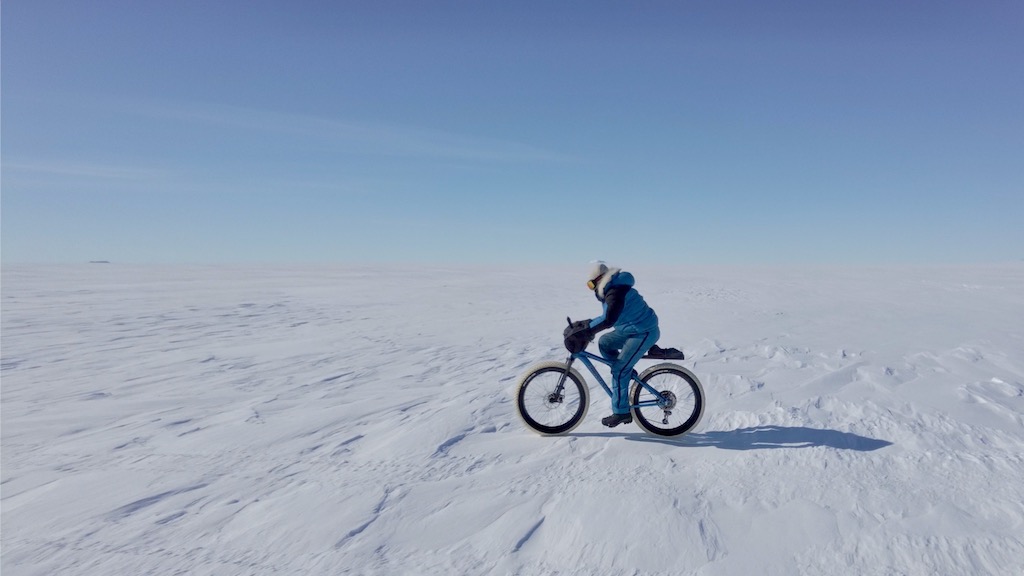
Queen Maud Land
Covid-19 interrupted five years after my last polar training expedition, where I tested fatbike No.4 in Iceland. I created an opportunity in partnership with sustainable luxury travel company, White Desert, to perform a unique expedition across Queen Maud Land in Antarctica. The ride – 201km over five days, from Wolf’s Fang Camp (1130m elevation), climbing to 1680m before descending to Whichaway Camp (100m elevation) – was the best possible preparation for Breaking the Cycle South Pole. The challenge was on the edge of what I can do. Due to the existence of several crevasse fields, I cycled with the protection of a support vehicle, tethered to it through the danger zone.
Queen Maud Land was not only a privilege, but an important chance to fine tune the logistics, test equipment and sharpen up for the challenge, mentally and physically. Even with my custom-made fatbike, it was a fine line as to whether I pedaled or pushed. In the end, I walked the bike for about 10 km over dangerously slippery ice and across a crevasse field (wearing crampons). A combination of extra soft snow and poor contrast (visibility) caused me to push a total of another 10km. The rest of the journey was pedaled. At the higher altitudes, struggling over the soft snow with the wind chill setting in, I longed for the extreme heat of Lake Disappointment.
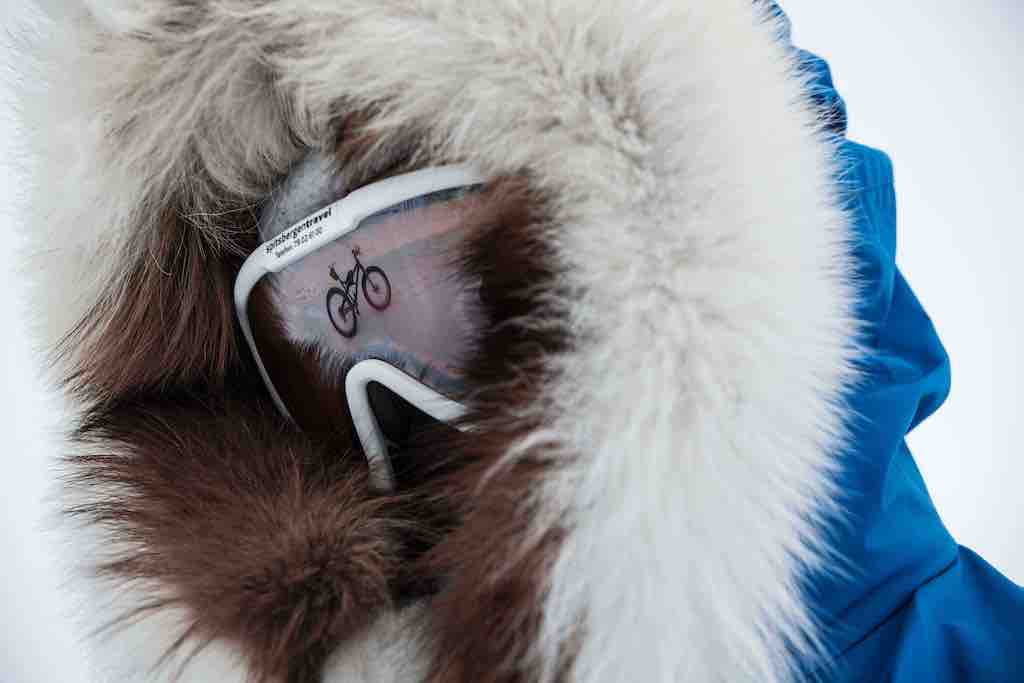
Breaking the Cycle South Pole
All this is leading to the final challenge, the Breaking the Cycle South Pole expedition; the first bicycle crossing of the Antarctic continent via the South Pole.
Antarctica is the coldest, highest, driest, windiest continent on Earth. I will face katabatic polar winds [high density downhill winds] as I pedal toward the South Pole and generally benefit from a tailwind on the way back to the coast. Surfaces will vary from the firmer compacted snow on the South Pole Overland Traverse to icy sastrugi sculpted by the wind to ‘bottomless’ soft, dry snow (the most dreaded surface for a cyclist). Temperatures are expected to range between -15̊C and -40̊C in the extreme case.
The race is on once again to secure the funding needed for the expedition to start in December 2024.



